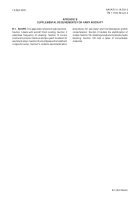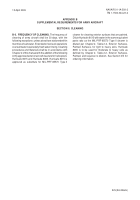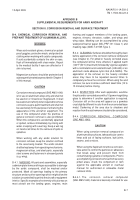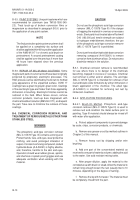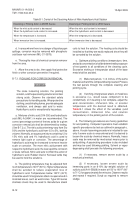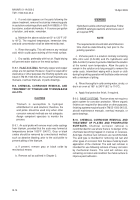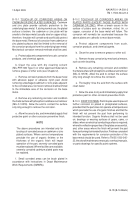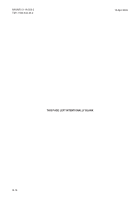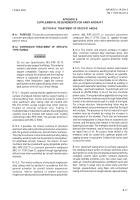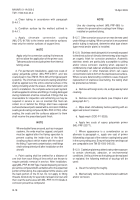TM-1-1500-344-23-2 - Page 212 of 240
B-10
NAVAIR 01-1A-509-2
TM 1-1500-344-23-2
15 April 2009
B-5.5. PAINT SYSTEMS. Use paint systems which are
recommended for aluminum (see TM 55-1500-345-
23). Treat touch-up of broken conversion films or
magnesium as described in paragraph B-5.6. prior to
the application of any paint system.
NOTE
The final protective paint system or primer shall
be applied on a completely dry surface and
shall be applied within 48 hours after application
of the AMS-M-3171 or chromic acid brush-on
pretreatment. A second pretreatment coating
shall be applied over the previous if more than
48 hours have elapsed since the previous
application.
B-5.6. REPAIR OF MIL-M-45202 COATINGS. Some
magnesium parts in current aircraft have been originally
protected by proprietary electrolytic processes. The
HAE process can be identified by the brown to mottled
gray appearance of the unpainted surface. DOW 17
coatings have a green to grayish-green color. Coatings
of the electrolytic type are thicker than those applied by
immersion or brushing. Electrolytic finishes cannot be
restored in the field. When failure occurs, remove
corrosion products, touch-up bare magnesium with
chemical treatment solution (AMS-M-3171), and repaint
the part. Take care to minimize the removal of these
coatings.
B-6. CHEMICAL CORROSION REMOVAL AND
TREATMENT OF FERROUS METALS OTHER THAN
STAINLESS STEEL.
WARNING
The phosphoric acid-type corrosion remover
(MIL-C-10578 Type III) contains a strong acid.
Protect hands, face, and eyes, wear protective
clothing, and avoid prolonged inhalation of
vapors. Corrosion removing compound, sodium
hydroxide base (A-A-59261) is highly alkaline,
and, therefore, harmful to the skin and eyes.
Operators should wear rubber gloves, aprons,
and chemical or splash proof goggles and use
adequate ventilation when working with this
material.
CAUTION
Do not use the phosphoric acid-type corrosion
remover (MIL-C-10578 Type III) if the danger
of trapping the material in crevices or recesses
exists. Steel parts heat-treated above Rockwell
C40 (180,000 psi) tensile strength are subject
to hydrogen embrittlement; therefore, the use
of the phosphoric acid-type corrosion remover
(MIL-C-10578 Type III) is prohibited.
Do not use the sodium hydroxide base corrosion
removing compound (A-A-59261) to remove
corrosion from aluminum alloys. Do not process
dissimilar metals in the solution.
B-6.1. Chemical corrosion removal is recommended
for use where there is no danger of the chemicals
becoming, trapped in crevices or recesses. Chemical
rust remover is either acid or alkaline. The acid type
(MIL-C-10578 Type III) is intended for removal of red
rust and black oxide formations by either immersion or
brush application of the chemical. The alkali type
(A-A-59261) is intended for removing red rust by
immersion treatment.
B-6.2. APPLICATION PROCEDURES.
B-6.2.1. Brush-On Method. Phosphoric acid-type
corrosion remover (MIL-C-10578 Type III) is used to
remove rust and condition the metal surface prior to
painting. Type III material should always be rinsed off
with water after application.
a. Protect adjacent components to prevent damage
by scale, chips, corrosion products, or chemicals.
b. Remove any grease or soil by method outlines in
Chapter 2 of this manual.
c. Remove heavy rust by chipping and/or wire
brushing.
d. Add one part of the concentrated material as
received to one part of water by volume, adding the acid
to the water. Use acid resistant mixing tanks.
e. After proper dilution, apply the material to the
corroded area with brush or swab. Allow the material to
remain long enough loosen the rust (usually two to 10
minutes, depending on the degree of rusting).
f. Remove the by with hot water. The material must
be completely rinsed from the part.
Back to Top


